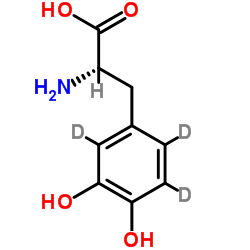53587-29-4
| Name | (2S)-2-amino-3-(2,3,6-trideuterio-4,5-dihydroxyphenyl)propanoic acid |
|---|---|
| Synonyms |
L-DOPA-2,5,6-d3
L-Tyrosine-2,5,6-d, 3-hydroxy- Dopa-phenyl-d3 MFCD00075014 L-Dihydroxyphenylalanine-2H3 3-Hydroxy-L-(2,5,6-H)tyrosine 2,3,6-trideuterio-4,5-dihydroxy-phenylalanine |
| Description | L-DOPA-2,5,6-d3 (Levodopa-2,5,6-d3) is the deuterium labeled L-DOPA. L-DOPA (Levodopa) is an orally active metabolic precursor of neurotransmitters dopamine. L-DOPA can cross the blood-brain barrier and is converted into dopamine in the brain[1][2][3]. |
|---|---|
| Related Catalog | |
| In Vitro | Stable heavy isotopes of hydrogen, carbon, and other elements have been incorporated into drug molecules, largely as tracers for quantitation during the drug development process. Deuteration has gained attention because of its potential to affect the pharmacokinetic and metabolic profiles of drugs[1]. |
| References |
| Density | 1.49g/cm3 |
|---|---|
| Boiling Point | 448.4ºC at 760 mmHg |
| Melting Point | 292ºC (dec.)(lit.) |
| Molecular Formula | C9H8D3NO4 |
| Molecular Weight | 200.20600 |
| Flash Point | 225ºC |
| Exact Mass | 200.08800 |
| PSA | 103.78000 |
| LogP | 0.75250 |
| Index of Refraction | 1.654 |
| Symbol |

GHS07 |
|---|---|
| Signal Word | Warning |
| Hazard Statements | H302-H315-H319-H335 |
| Precautionary Statements | P261-P305 + P351 + P338 |
| Personal Protective Equipment | dust mask type N95 (US);Eyeshields;Gloves |
| Hazard Codes | Xn |
| Risk Phrases | R22 |
| Safety Phrases | 26-36 |
| RIDADR | NONH for all modes of transport |
